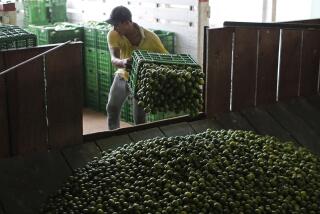Standoff Over Land Continues in Mexico
SAN SALVADOR ATENCO, Mexico — When the government decided last fall to relocate Mexico City’s airport to a mostly dry lake bed east of the capital, the loudest objection came from environmentalists who feared the loss of a winter home for tens of thousands of migratory birds.
Few outsiders worried about the thousands of small farmers who also would be displaced from the land of their ancestors.
From the start, the farmers have resisted a government mandate to leave their homes and fields in return for cash. They have blocked roads, gone to court and tried to march on President Vicente Fox’s official residence--all to no avail.
Now, taking inspiration from southern Mexico’s Zapatista guerrillas, they have donned ski masks and turned to violence. On Thursday, they hijacked and burned vehicles, attacked police with machetes and seized hostages, bringing Mexico’s bloody history of land feuds to the country’s biggest public works project of the new century.
The conflict, in which 30 people have been injured, settled into a tense standoff Friday between leaders of the uprising and the state of Mexico. Each side was demanding the release of captives held by the other.
Late in the day, police freed three of 15 farmers who were arrested Thursday.
As riot police lined up in trucks outside this barricaded farming settlement, about 350 people set off firecrackers and chanted anti-government slogans in the central plaza. The crowd, which included women and children, guzzled Coca-Cola from two trucks hijacked by the farmers and saved the bottles to make firebombs.
At least 30 vehicles, including stolen trucks and burned police cars, blocked all entrances to the town, located near a huge garbage dump 18 miles east of Mexico City, causing a monumental traffic jam. Hundreds of farmers, many armed with machetes and metal pipes, were taking part in the protest.
In the town’s auditorium, protest leader David Pajaro paraded seven hostages before television cameras. They included a state prosecutor and police officers.
Disavowing threats by some protesters to kill them, Pajaro said the hostages had not--and would not--be harmed. Two of the hostages were allowed to speak to reporters. They said they were being treated well but feared that they would be killed if police tried to rescue them.
Pajaro offered to free the hostages in exchange for the farmers arrested Thursday. He said his group was negotiating with state authorities.
“It’s up to the government to resolve this situation,” he said. “If that is done, we will go back to the way we were, everybody in peace.”
The state’s attorney general, Alfonso Navarrete Prida, said most of the protesters might soon be freed on bail. The three released late Friday had nothing to do with the uprising, his office said.
But Gov. Arturo Montiel said officials refused to discuss a release of two protest leaders, who face more serious charges of inciting violence and stabbing a policeman.
Families comprising 34,000 people hold title to the 13,300 acres in 13 communities that would be swallowed by the $2.3-billion airport, to be the largest in Latin America. The area once was under Lake Texcoco, part of Mexico City’s Aztec-era water system.
Fox’s administration chose the area in October over a more expensive and distant site in Hidalgo state. The new six-runway airport would enable the government to close Mexico City’s overcrowded Benito Juarez International Airport, which is hemmed in by homes and businesses on the eastern side of the capital.
To appease environmentalists, who had been struggling to recover the ancient lake network, the government promised to create reservoirs and parklands near the new airport. Environmentalists are still challenging the project.
But the farmers’ revolt now has taken center stage.
The government would give residents as little as seven pesos, or 70 cents, per square meter of land.
“What are we going to do with seven pesos?” asked Francisco Jaime Contreras, 54, a corn farmer in the nearby village of Santa Ana. “It’s not enough even to buy refreshments.”
Others have refused to move no matter what they are offered.
“I would give my life instead,” said Jesus Gonzalez, 22, a machete-wielding farmer from the village of Acuexcomac. “Our land is like a mother to us.”
Such words are not idle talk in Mexico, where bloody disputes between peasants and large landowners helped fuel the revolution of 1910, which led to a massive land redistribution.
The land in the Texcoco area is held in ejidos, government titles won during the revolution and handed down over generations. The central plaza here features a large mural of revolutionary heroes, including peasant leader Emiliano Zapata.
Speaking to reporters in the plaza, Pajaro said the farmers were following the example of Zapatista rebels in the southern state of Chiapas, who took their name from Zapata and led a 1994 uprising in the name of Indian rights.
The violence began Thursday when dozens of farmers blocked a highway near Santa Catarina, 25 miles northeast of Mexico City.
After order was restored there, a second group of protesters began blocking highways around this town, taking hostages and seizing and burning vehicles. Protest leaders said riot police started the violence by forcing their peaceful caravan off the road and attacking their group with clubs.
*
Times staff writer Boudreaux reported from Mexico City and special correspondent Aguirre from San Salvador Atenco.
More to Read
Sign up for Essential California
The most important California stories and recommendations in your inbox every morning.
You may occasionally receive promotional content from the Los Angeles Times.










